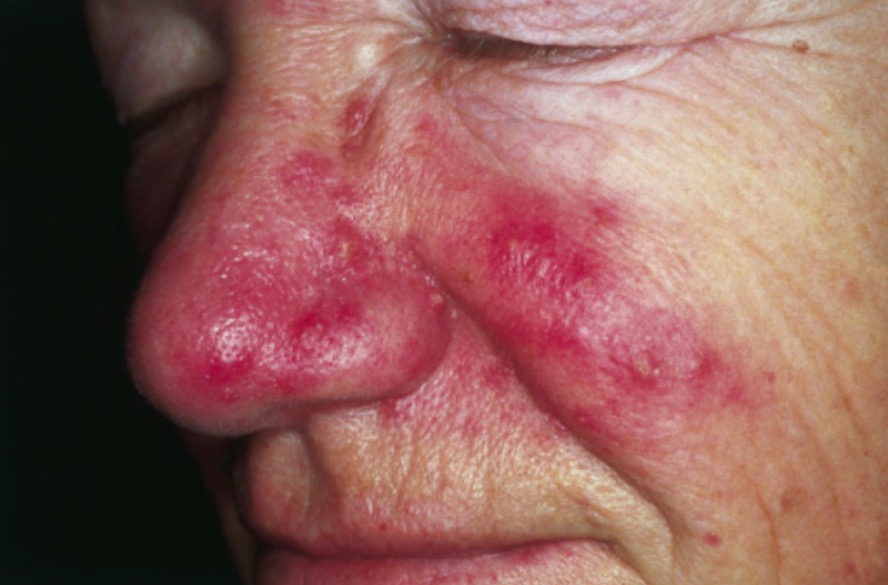Playlist
Show Playlist
Hide Playlist
Rosacea: Pathophysiology
-
Reference List Pathology.pdf
-
Slides Rosacea Pathophysiology Dermatopathology.pdf
-
Download Lecture Overview
00:01 Welcome. In this talk we're going to discuss rosacea. 00:05 Rosacea is actually very interesting. 00:08 It's an inflammatory dermatosis that has a curious predilection classically for the center of the face, and also has an effect profoundly on vasculature, so that you get really red areas in the middle of the face, hence the name rose-colored or rosacea. 00:26 It's chronic inflammation. 00:28 It is associated, as I said, with capillary hyperreactivity. 00:32 The picture that you're seeing is actually very classic for rosacea. 00:37 Again center of the face, very vascular. 00:40 So what's the epidemiology of this. 00:42 It is not that uncommon. 00:45 You probably have an older uncle, aunt, grandfather, some relative that may have this. 00:51 So about 5% of the population worldwide typically in the older age group when it starts, but then if it's not effectively treated, can get more and more and more apparent and profound. 01:03 Women tend to be more affected than men, and it is more common in fair-skinned individuals, in fact distinctly uncommon to be seen in people with hyperpigmentation. 01:13 So what's the pathophysiology? How do we explain this kind of central location? How do we understand what's going on with the vasculature. 01:22 Well okay I'm going to wave my hands furiously. 01:25 We don't know. The exact etiology is not understood. 01:29 And if you're looking for a project as a young budding dermatologist, this is something you can look at. 01:34 There is clearly a genetic predisposition that does run in families. 01:38 And we know that there are some associated risk factors. 01:42 So infections in particular demodex mites. 01:45 So we all have some microbiome on our skin. And to varying extents we may have small mites. 01:54 It turns out that if you have kind of a hospitable environment for those mites, you're more prone to getting rosacea. 02:03 Interestingly, Helicobacter pylori, not on the skin, but as a gastric infection. 02:09 And you may be aware that Helicobacter is associated with gastric ulcers. 02:14 That also gives rise, it can be a risk factor for rosacea, but it's the infection in the stomach. 02:23 And then perhaps secondary cross-reactivity to the bacteria in a susceptible host. Ultraviolet radiation, probably by causing local damage over that sun-exposed area, may explain some of the predilection for the nose and kind of malar eminence. 02:41 And then there's also the predisposition for individuals who have vascular hyperreactivity, so they get prolonged flushing. 02:47 So some people, as you probably are aware, when they exercise, get redder in the face than other people. 02:53 Some people have much more profound vascular congestion in hot weather, or with spicy food, or with alcohol use, or with stress. Those individuals are going to be more prone to having the secondary vascular effects associated with rosacea. 03:09 So the exact mechanism. 03:11 So we have some trigger. 03:14 It can be an infection. 03:16 It can be heat. It can be toxins maybe ultraviolet light any of a variety of things that cause some initial damage okay. 03:24 The host responds appropriately. 03:27 So then we recruit basically innate immunity. 03:30 We're going to recruit not T cells so much as macrophages and neutrophils to this site of local injury. 03:37 The production of interleukin one, chemokines and a variety of other growth factors are going to affect that local environment. So we have some stimulus, waving my hands now, secondary innate immunity responding to that. 03:55 And then we start getting into the kind of vasogenic and neurovascular component that makes it so red. 04:03 So there's stimulation, the various cytokines that are produced, some of the growth factors, some of the chemokines and some of the mediators, such as proteases or reactive oxygen species from that innate immunity are going to act on nerve endings. 04:18 And remember that although the epithelium itself doesn't have nerves within it, nerve endings do contact and interdigitate with the epithelium. 04:31 The factors that are being produced by the innate immune response stimulate those nerves, and we get feedback and into the nervous system. 04:40 So we get kind of a neural sensitization. 04:43 Well it goes both ways. 04:44 It's not just into the central nervous system perceived as pain or a variety of other effects. 04:51 It's also driving pro-inflammatory effects such as vasodilation. And we will have neural input. 04:59 Again, this is that genetic predisposition to people who are more prone to flushing, so that endogenous triggers will drive the stimulation of the vasomotor response. 05:10 So we will get So dilation and increased vascular permeability as part of that. But a combination of the inflammatory milieu and then the neural input gives rise to this profound ongoing neurovascular response. 05:28 And that's going to be giving rise to the flushing and that central erythema.
About the Lecture
The lecture Rosacea: Pathophysiology by Richard Mitchell, MD, PhD is from the course Inflammatory Lesions of the Skin.
Included Quiz Questions
What is the approximate worldwide prevalence of rosacea?
- 5%
- 10%
- 15%
- 20%
- 25%
Which infection has been identified as a risk factor for rosacea despite not being present on the skin?
- Helicobacter pylori
- Staphylococcus aureus
- Streptococcus pyogenes
- Candida albicans
- Malassezia furfur
What is the primary mechanism responsible for facial redness in rosacea?
- Neurovascular response with vasodilation
- Direct bacterial damage to vessels
- Melanin accumulation
- Decreased blood flow
- Epidermal thickening
Customer reviews
5,0 of 5 stars
| 5 Stars |
|
5 |
| 4 Stars |
|
0 |
| 3 Stars |
|
0 |
| 2 Stars |
|
0 |
| 1 Star |
|
0 |




